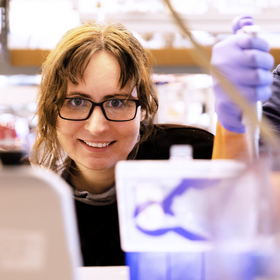

Kate
Adamala
Synthetic minimal cells are programmable bioreactors with some, but not all functions of live natural cells. Those designable biological systems allow studying of natural life processes, investigating genetic pathways on single-cell level, and modelling species and whole population level interactions. We can also engineer novel pathways and artificial biological systems, for biotechnology, basic science, space exploration, biosafety and biomedical applications.
Research statement
We are building and studying synthetic cells, with applications in basic research, biomanufacturing, medicine and space exploration. Synthetic cells are liposomal bioreactors that can mimic natural biology, as well as create new functionalities from biochemical parts. Building cells from scratch, we study the origin and early evolution of life, we study complex modern cells and also explore alternative ways to do "life". We use synthetic cell technologies to make tools for metabolic engineering, drug development, and biosensing. We explore possibilities of using synthetic cells as biocomputers, and as bioreactors for space missions. We use techniques of cell-free protein expression, liposome encapsulation and RNA engineering, combining existing synthetic biology tools and building new ones. Lineage-agnostic biology of synthetic cells allows us to apply engineering principles to study biological processes, with an experimental system that we control and understand, while maintaining complexity relevant to natural life.
Founding member and one of the leaders of the Build-a-Cell collaboration
Selected publications
Engineering genetic circuit interactions within and between synthetic minimal cells; Katarzyna P. Adamala*, Daniel A. Martin-Alarcon*, Katriona R. Guthrie-Honea, Edward S. Boyden; Nature Chemistry, 2016, doi:10.1038/nchem.2644; *equal contribution
Programmable RNA-binding protein composed of repeats of a single modular unit; Katarzyna P. Adamala*, Daniel A. Martin-Alarcon*, and Edward S. Boyden; PNAS, 2016, 10.1073/pnas.1519368113; *equal contribution
Collaboration between primitive cell membranes and soluble catalysts; K. Adamala*, A. E. Engelhart* and J. W. Szostak; Nature Communications, 2016, doi:10.1038/ncomms11041; *equal contribution
A simple physical mechanism enables homeostasis in primitive cells; A. E. Engelhart*, K. Adamala*, and J. W. Szostak; Nature Chemistry, 2016, doi:10.1038/nchem.2475; *equal contribution
Generation of Functional RNAs from Inactive Oligonucleotide Complexes by Non-enzymatic Primer Extension; K. Adamala*, A. E. Engelhart* and J. W. Szostak; J. Am. Chem. Soc., 2015, 137 (1), pp 483 - 489, DOI: 10.1021/ja511564d; *equal contribution Competition between model protocells driven by an encapsulated catalyst; K. Adamala and J.W. Szostak, Nature Chemistry 5 (2013) 495 - 501;
Non-enzymatic template-directed RNA synthesis inside model protocells; K. Adamala and J.W. Szostak, Science 342 (2013) 1098 - 1100;